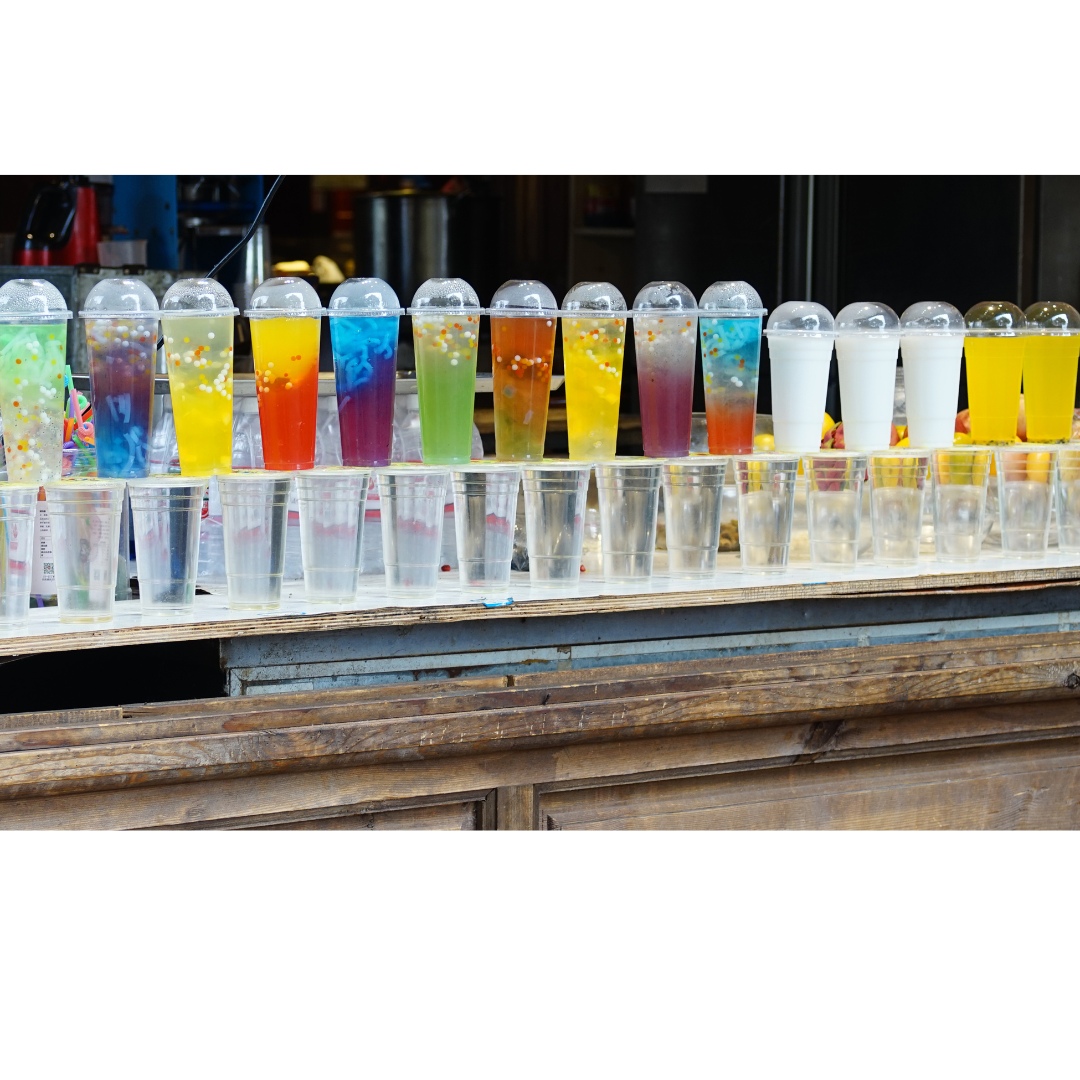Start your own Bubble Tea Business
Currently, as one of the most popular, profitable and high demand items out there - bubble tea is a clever choice when starting a business.
It has low start-up costs, as you do not require much expensive equipment and you can organically fund your equipment as you grow.
Plus, it's a high-margin product and easy to operate.
Bubble tea is a tea-based cold drink that originated in Taiwan in the early 1980s.
These drinks look absolutely gorgeous with its uniqueness being the pearls (Tapioca or popping boba) that gets sucked up in a wide straw as you drink!
There are two main types namely milk-based or water-based bubble teas.
Your milk-based bubble tea consists of pre-cooked chewy tapioca pearls, a brewed tea, milk flavoured with a milk powder and sweetened with simple syrup or condensed milk.
Your water-based bubble tea consists of popping bobas (or jellies), a brewed tea flavoured with sugar syrup or a pre-mixed ice-tea concentrate.
The drink also contains lots of ice that makes it truly refreshing.
Tea is usually the base of the drink, which can range from black teas to green teas or South Africa's favourite - Rooibos Tea.
But there are also other varieties (like coffee, fizzy drinks or even alcohol!), because there are no hard & fast rules in making bubble tea. It's a very versatile drink and you have endless possibilities!
We share just some of the main varieties here, that really do depend on your target audience's taste palette (preference):
Start with water-based bubble tea: (See how to make a water-based bubble tea)
It is super simple to make and usually loved by the younger audiences and children, because of its sweeter taste.
For audiences who prefer tea, making your water-based bubble tea with a weak tea and then flavouring it with a sugar syrup would be ideal.
Or you can rather use an ice tea concentrate as the base. This is a much sweeter option, that is usually adored by children especially.
Then try the milk-based bubble tea: (See how to make a milk-based bubble tea)
It is also simple to make, but a bit more involved, since you need to cook the Tapioca pearls beforehand. This usually appeals to a slightly older target market such as young adults or grown-ups with more a sophisticated taste palette.
You will first need to decide on your setting and concept. Are you thinking of a sit-in and dine-in type of location or more of a grab and go location?
This will influence your capital cost in perhaps purchasing or renting a permanent shop or a mobile cart or kiosk.
You will then need to decide if you want to build your own brand or rather buy a franchise.
If you want to build your own brand, you'll need to design your own menu, conduct your own marketing research and planning (you can build on other recipes and ideas).
With a franchise, your menu is already set and your brand is already established. But you will need to pay royalties.
Both of these options come with their own sets of pros and cons.
If you do start your own brand, water-based bubble tea is the best place to start, due to its simplicity. The secret is to first order small quantities, only a few varieties and then to build and add to your menu. Test drinks and later incorporate milk-based bubble teas.

To help you in purchasing the right amount of inventory for your start-up, follow this link to our water-based Bubble Tea Quantities Page.
We are busy working on a Milk-based Bubble Tea Quantities Page as well.
It is important to do your own market research before deciding on the menu for your bubble teas. But to give you some ideas, here's our Ice Tea Recommendations Page and our Syrup Recommendations Page for your Popping Boba
We also provide you with various recipes and how-to guides on making bubble teas, on our Guides & Tips Page. We regularly update content on this page to crown you with as much bubble tea knowledge as possible!
You can sell a single bubble tea drink anywhere from R40 to R70 or even more, depending on the type of ingredients used, your setting, and the choice between milk-based or water-based creations. For example, a shopping mall might call for higher selling prices compared to you selling from a kiosk at a festival.
Importantly, you will need to factor in your shop's location, rent, utilities, and operational expenses when working out your cost per drink.
Remember, the price range for each bubble tea drink is versatile, allowing you to align with your business goals and customer expectations. Our Bubble Tea Calculator and Quantities Page serve as invaluable tools, offering insight into ingredient costs and helping you make informed decisions.
Crafting the perfect selling price involves a delicate balance—a price that entices your customers while securing profitability for your budding business venture.
Bubble tea can be sold in various settings, catering to different customer preferences and demands. This list will give you an idea of what setting could work best for your concept and budget:
-
Dedicated Bubble Tea Shops or Cafes: These specialty shops exclusively focus on serving a wide range of bubble tea flavours and variations.
-
Food Courts and Shopping Malls: Stalls or kiosks in malls or food courts often offer bubble tea alongside other beverages and snacks.
-
Restaurants and Eateries: Some restaurants, particularly Asian cuisine establishments, include bubble tea on their beverage menus.
-
Street Vendors and Mobile Trucks: Street vendors or food trucks specialize in bubble tea, offering convenience to passersby.
-
Campuses and School Tuck Shops: Bubble tea is popular among students, so many campuses have dedicated bubble tea kiosks or shops.
-
Cinemas and Entertainment Venues: Some cinemas and entertainment complexes offer bubble tea as part of their refreshment options.
-
Online Platforms and Delivery Services: With the rise of online ordering, many bubble tea shops offer delivery services through apps or their websites.
-
Events and Festivals: Bubble tea vendors often set up stalls at festivals, farmer markets, or cultural events to attract a diverse audience. This is also quite popular with schools during sports or fund raising events.
-
Office Buildings and Business Districts: Bubble tea shops strategically located near offices cater to professionals looking for a refreshing drink.
As mentioned, you do not need expensive equipment to start a bubble tea shop. But there are some essential equipment that is crucial for operations.
Here's a breakdown:
-
Drinkware and Accessories: Cups, lids, straws (thick and wide for the pearls) and sealing films.
-
Shaker Cups: For blending the tea, flavours and ingredients manually.
-
Storage Solutions: Cabinets, shelves, or storage units for inventory, supplies, and equipment storage.
-
A portable sink or hand-washing station: To maintain hygiene standards for washing of hands and of utensils.
-
Trash Receptacle: An easily accessible trash bin to maintain cleanliness and dispose of waste responsibly.
-
Work Surfaces: Countertops or surfaces for preparing drinks and assembling ingredients. These could be foldable tables or built-in counters.
-
Dispensing Bottles or Containers and dispensing pumps: For storing and dispensing boba, tapioca, syrups and other ingredients. These usually come with the ingredients that you purchase from your supplier.
-
Serving utensils: Various utensils to serve your drinks such as boba scoops, tongs for the ice and measuring spoons.
-
Point-of-Sale (POS) System or Cash Register: Essential for transactions and basic sales tracking.
Commercial Refrigeration: A refrigerator or under-counter cooler for storing perishable ingredients and a freezer to keep the ice.
Display, branding & signage: Signage and Branding: Visible and attractive signage displaying the menu, brand name, and offerings to attract customers. A board or display showing available drinks, flavours and prices is essential.
This selection focuses on the absolute essentials needed to start serving water-based bubble teas while keeping initial costs as minimal as possible. It allows for basic preparation and serving capabilities while maintaining a focus on budget constraints. As the business grows, additional equipment and resources can be gradually added to enhance efficiency and expand the menu offerings.
Later you may consider purchasing a sealing machine for the cups, an ice-maker, a shaking machine, automatic tea brewers and blenders, cooking equipment for preparing tapioca pearls and/or expanded refrigeration units,
Before embarking on this exciting journey, there are a few important factors you'll need to consider and research that you need to do!
1. Know your customers - Make sure you understand the market you want to target. Especially their taste preferences, because this will undoubtedly influence your menu items. For example, are they sophisticated tea drinkers or lean more towards sweet drinks? For example, if they lean more to sweet drinks, you'll rather focus on creating water-based bubble tea drinks from ice tea concentrates, rather than from actual tea. More sophisticated tea drinkers would rather prefer black teas, Rooibos or green teas.
2. Align Values - It's important to do your research on what your type of customer values. This will help your brand to connect with them on a more personal level. For example, if they value sustainability, providing their drinks in glass jars for example, will connect you better.
4. The trick is volume - With bubble tea, to be profitable is to sell high volumes of drinks. Make sure you choose your location accordingly.
6. Increase your average order value - Because bubble tea is a high volume game, serving something with your drink, like a waffle, a pancake or a panini, could really up the value per order.
7. Build a System - This is a crucial step in making sure your ordering system, making of the drinks' system and delivering system are all consistent every time.
Customers need to experience fast, friendly and efficient service. Working hard on this step is really going to make or break your bubble tea shop. Test your system regularly and eradicate any discrepancies and frictions.
8. Hire the right Labour - The people you hire should be aligned with your own personal values and that of the business.
9. Calculate your start-up costs & consider all the running costs - Consider the equipment you'll require, the set-up of your shop or mobile cart. Inventory costs will be based on how much you estimate making per month. You'll need to consider your marketing costs. Your rent and/or royalties. And most importantly, always keep a buffer - in case of emergencies.
10. Marketing - Utilise popular social media platforms. Generate UCG (User generated content), because it carries more weight what others say about you, than yourself.
Use third party delivery apps as a marketing tool and slip a voucher with your deliveries encouraging customers to rather order directly from you.
